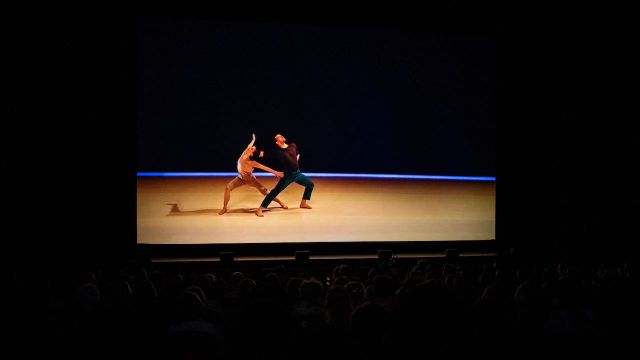Six Years Later and BLKDOG
This Sadler’s Wells double bill is the third of four live-streamed events in the 2021 Adelaide Festival’s ‘Live From Europe’ series with patrons watching the performances on a cinema screen. The artists are performing live in their own time zone and can see and hear the Adelaide audience as we attend the theatre at night in our zone. An excellent concept in our unusual, virus-affected present, and a solution that has worked well overall with packed houses and live introductions from our Festival Directors and the artists/producers in Europe.
The first work in this program was Six Years Later performed by dancers Natalia Osipova and Jason Kittelberger, a work choreographed by Roy Assaf and first recreated for Natalia Osipova’s Pure Dance programme produced by Sadler’s Wells in 2019. Assaf was born in 1982 in the rural community of Sde Moshe in southern Israel. His work has been performed in such renowned venues and festivals as the Théâtre National de Chaillot, Jacob’s Pillow, Bolzano Danza, Pavillon Noir, Biennale di Venezia and the 17th Biennale de la Danse in Lyon and has been awarded internationally.
It is rare for a prima ballerina to make a successful transition to performing contemporary dance, with the notable exception of Sylvie Guillem, and now Osipova. There is a distinct difference in the way classical ballet and modern dance utilise a dancer’s centre of gravity, their upper body flexibility, and contact with the floor, and not all performers will be comfortable with those shifts. Osipova has proven her mettle as a classical ballet star after training in Russia, achieving principal status with the Bolshoi and Mikhailovsky Ballet and guesting with companies across the world. In 2012 she became a principal of American Ballet Theatre, moving on to The Royal Ballet in London soon after. English choreographer Alastair Marriott says of Osipova ‘Natalia is the closest I've come to realising my ideal… She has all the makings of a great modern ballerina, but she also has a quality of abandon and freedom that reminds me of Isadora Duncan. She has such strength, she is so dynamic, yet she also has extraordinary delicacy and femininity. She's a free spirit – there's something fearless about her. And when she does a jump, it's massive.’
In Assaf’s Six Years Later there are none of the famous jumps but rather a tender, emotional journey with moments of anger and remorse represented by complex lifts, floor work and gestural patterns. Still, the sinuous Osipova manages to embrace the form and shine. American trained Jason Kittelberger is a generous and exceptional dancer and partner in this work and perfectly complements Osipova in both technique and emotional range. The deceptively simple choreography traverses an emotional timeline, perhaps one couple, perhaps a ‘universal’ coupling, and the highs and lows of connection and is accompanied by an eclectic, edited score using music from Deefly, Beethoven, and Marmalade. I believe the work benefited from being viewed on the large screen as the inner emotional landscape was very clear and affecting.
South-London born choreographer Botis Seva has drawn from both hip hop and contemporary dance language to create an energetic synergy for his work BLKDOG which won an Olivier Award for Best New Dance Production in 2019. Working with his own Far From The Norm company dancers Hayleigh Sellors, Jordan Douglas, Joshua Nash, Shangomola Edunjobi and Ezra Owen, Seva uses images and inspiration from contemporary life unfolding around him. He states that the work has shifted somewhat since its premiere in 2018, originally reflecting internal trauma (his and the company members’), it now focusses on humanity’s ‘locked in feeling’ and Seva hopes that we can all look forward from now to a more playful, less complicated future.
The work viewed on film was set in unrelentingly dark and shadowed lighting, so I am not sure the playfulness was revealed. The choreography contained sections of tight, energised unison where the dancers seemed to appear as one organism. Other moments were floor-bound with contained but restless energy that would ignite in moments of chaos to then coalesce once more to a pedestrian and unison travelling sequence. There are snippets where the dancers scuttle like spiders skimming the ground with lightness and suppleness and a general air of clutching at survival in a fiercely difficult world as the hooded figures clasp one another tightly.

The remarkable score for BLKDOG was provided by Seva’s long-time collaborator Torben Lars Sylvest, a music producer and sound designer who was largely self-taught during his late teens and early twenties. Sylvest now collaborates with other dance companies and uses sampling from unconventional sources blending them with field recordings to produce his original works.
Two dance works, two different moods and a multitude of images and emotions all displayed on the large cinema screen in this cross-Atlantic collaboration True Festival fare where we are fortunate to view artists at the peak of their creativity, even if they cannot travel to us.
Lisa Lanzi
[Note : With approximately 8 minutes remaining, the final work BLKDOG experienced technical difficulties in London (lighting/electrical failure) so that the live stream was suspended. With no news of how soon this might be rectified, and after waiting for a time, I had to leave to attend another event - as did others in the audience].
Click here to read more Adelaide Festival 2021 reviews.
 Photographer: Andrew Beveridge.
Photographer: Andrew Beveridge.
Subscribe to our E-Newsletter, buy our latest print edition or find a Performing Arts book at Book Nook.

